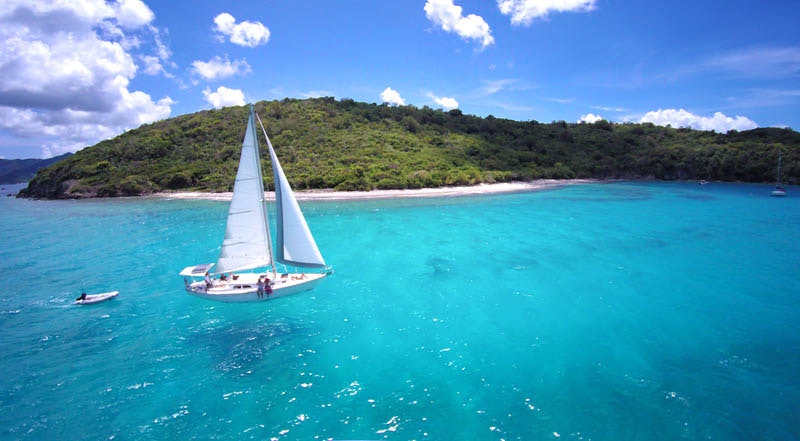Thinking of learning to sail? Read on to find out about where to take lessons in the UK, holidays and the Olympics
Sailing has been around for travel and fishing, but it’s only become a sport since the early 17th century. The Dutch are said to be the first nation who raced yachts for fun. They gave a ship to Charles II and the sport quickly became popular in England before being taken up in America.
Up until the second half of the 20th century, yachting was a luxury sport for the rich. However, during the 1950s and 60s, new materials became available – such as plywood – which made boat construction easier and cheaper than ever before, making the sport more accessible to everyone.
Today, it is a pastime enjoyed by millions of people worldwide – both competitively and non-competitively on lakes and rivers to the wide open ocean.
Sailing In The Olympics | An Essential Guide To The Rio 2016 Events, The Rules And Schedule
Sailing specifically refers to the sport of using wind to power sails and propel the boat forward (rather than engines). Unlike windsurfing and surfing, the sport takes place in an enclosed boat rather than on a board.
Today it is mostly a recreational activity. There are two types of sailing – racing and cruising. Racing is the branch of yachting you will recognise from the Olympics, however cruising is probably what most people would enjoy on their holidays or on the weekends.
You can learn to sail on a yacht (usually around 9m long and can fit multiple people onboard) or a dinghy (around 2m to 4m long and fit one or two people inside).

One of the best ways to learn to sail is in a dinghy. Photo: iStock
Learning to sail takes a couple of days of tuition – but generally it’s a sport you will be able to pick up quickly in the right conditions. Gentle winds make for perfect weather for beginners.
The great thing about sailing is you can learn to sail a boat on your own from a young age. Children as young as eight years-old can learn to sail in Optimist dinghies – and many elderly folk in their 90s still go sail today.
WHERE CAN I LEARN TO SAIL IN THE UK?
You don’t have to live near the sea to learn how to sail. There are plenty of centres across the country on inland lakes and rivers, as well as coastal schools.
The Royal Yachting Association (RYA) is the national governing body for sailing in the UK – it’s qualifications are widely recognised across the world, so if you learn to sail in the UK, you can take your certificates with you pretty much anywhere.
Despite the name, the RYA doesn’t just teach people to sail yachts – you can learn to sail single-handed dinghies as well, which is a really good way to get a proper understanding of how the wind works before you move into larger boats.

It’s a good idea to book onto a course when learning how to sail. Photo: iStock
We would recommend joining onto a beginners course or taking a couple of private lessons before taking a boat out by yourself. Most centres will require you to have at least an RYA Dinghy Level 2 before they let you hire a boat.
The RYA has a great list of registered schools for learning to sail. All you need to do is work out which course you want to do (if you are an adult, RYA Level 1 is a good place to start) then the website will help you search for your nearest training centre by typing in your postcode. It’s as simple as that.
Most beginner RYA sailing courses run for four days. For example, this beginner sailing course at at Hillingdon Outdoor Activity Centre in west London costs £230.
Beginner Sailing Courses In London: Where Can I Learn To Sail?
You will be working towards gaining your RYA Level 1 and 2 dinghy qualification, which means have the basic skills to sail steer a single-handed dinghy in all wind direction and safely cast off/moor up.
From there, you can work towards your RYA Level 3 and then Seamanship skills. A great way to continue practicing your new-found skills is by racing. Ask your local club when they run friendly regattas, often anyone can join in.
WHAT SAILING GEAR DO I NEED?
When learning to sail, the number one piece of equipment I would recommend buying is a pair of neoprene shoes. You’ll wear these – rain or shine – in a dinghy. You can buy a pair from as cheap as £5 from M and M. It’s better to get a pair of longer ankle-high boots if you plan on sailing in winter.
What you wear really depends on the weather and time of year. If it’s a super hot sunny day in the middle of August and you are learning to sail on a small inland lake, then you can get away with wearing normal shorts and t-shirt.

However, water in the UK is notoriously cold even in the summer months, so it is best to be prepared. On windy days when there’s a high chance of falling in the water, it’s a good idea to wear a wetsuit and cagoule.If you are learning to sail on a course, they will often provide these for you but best checking when you book. When you start to sail more regularly, it’s a good idea to buy a wetsuit – these can be as cheap as £50.During the winter months, you need to layer up even more. Sailing gloves are advisable, as well as a warm hat. In freezing temperatures, sailors often opt for drysuits – waterproof suits that you can wear over warm clothes. Even when you fall in the water, you will remain bone-dry.
However, these are expensive to purchase and most centres won’t rent them out, so maybe something to consider buying further down the line if you decide to sail frequently in the winter.
It’s worth noting that clothing for dinghy sailing and yachting, while similar has some significant differences. Bear in mind that when you sail a dinghy you are far more likely to get wet than on a 30 foot yacht.
Buoyancy aids or life vests are an essential piece of equipment to wear when you go sailing. When you book onto an RYA course, the centre will provide these so you don’t need to buy your own.
For more detailed information about sailing clothing, read our article.
WHERE CAN I GO ON A SAILING HOLIDAY?

Great Britain is one of the windiest places in Europe, so there are some great places to go on a boating holiday in the UK. The south coast of England is a popular place to sail – stretching from Southampton and the Isle of Wight all the way down to south Cornwall and the Isles of Scilly.
Weymouth in Dorset was home to the Olympics back at London 2012 and has a great sailing centre there.
Meet The Surfer Who Has Spent The Last 10 Years Sailing The World… With Her Cat
The Lake District is a beautiful place to sail. For nervous beginners, heading out on a lake is often more comforting than heading out into the sea. The Llŷn Peninsula in Wales is also a great place to sail – it is even classed as a ‘European Centre of Excellence’ for the sport.
Scotland has numerous lakes that are great for taking a boat out. The west coast of Scotland is also well-known with beautiful views around the remote island off Largs. Read more about best places to go sailing in the UK here.
If you are looking to head abroad, Greece, Turkey, Spain, south of France and the Caribbean are all popular places to go on sail holidays.
Want to know the best places in the world to go on a sailing holiday? Read our article.
Sailing became part of the Olympics back in 1900. The sport grew in popularity in the 1960s as more nations began to take part. Today there are 270 athletes from 62 countries competing at the Rio 2016 Olympic Games. Find out more about the Olympic sailing events here.
Racing is one of the most exciting parts of watching sailing. Check out these crazy sailing crashes here.
You Might Also Like:
Skateboarding And Surfing To Be Confirmed As Tokyo 2020 Olympic Sports By The IOC
Sailing In The Rio 2016 Olympics: A Brief History Of The Sport
source:https://mpora.com/




